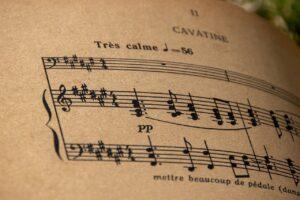Estimated reading time 6 minutes
Table of Contents
Introduction
Want to have better vocal tone? Want to sing in tune? Singing is all about the vowels. Vowels have a central role in singing, because the vowels impact your tone. Also, they impact how you tune when you harmonize. This happens when sound passes through the formants – the resonant folds in the vocal tract. The formants filter your voice’s harmonic overtones, which affects your harmonic intonation. Read more to learn about singing in tune with vowels.
This article takes a closer look at the nineth section of the post 10 Elements that Impact Singing in Tune.
Today’s post discusses scientific evidence showing you how vowels impact your vocal tuning. For practical advice on how to sing:
- Performing Schwa Vowels
- Performing Tongue Vowels
- Performing Lips Vowels
- The Intonation Flight Simulator
- Sing in Tune Like a Rock Star
Also, I’ve included a video on vowel production below.
This article uses technical musical terms. For definitions, see the Glossary at the end of the post.

Singing in Tune with Vowels [Ma] and [Mo]
The Quotes
The first intonation study we’ll examine looks at singing in tune with vowels. Hagerman and Sundberg found that, in a barbershop setting, the vowels did indeed have an impact on the tuning.
“As different vowels were used when the two quartets sang their cadences, the effect of vowel on intonation should be examined. This can be made by comparing the averages pertaining to the [ma] – and [mo] – cadences as sung by quartet B. Fig. II-A-2 shows the correlation” (30).
To look at Fig. II-A-2: click on this link. The chart can be found on page 8 of the PFD file (or page 33 in the document).
They go on to say, “With respect to interval averages the correlation coefficient is very close to 1, but the slope of the best fitting line deviates slightly from 1. This indicates that narrow intervals were sung some cents narrower and the widest intervals were sung somewhat wider on the syllable [mo] than on the syllable [ma]” (30, 32).
Now, many of you may be confused by the second quote. In the next section, we’ll take a closer look at exactly what it means.

Regression Analysis and Statistics
The problem with many intonation studies centers around the fact that they have been conducted by scientists, including music psychologists.
- They write their papers with an eye toward peer review, where everyone reading the paper has the background to understand the language and concepts.
- Therefore, your average musician will find it difficult to understand the implications of what the above quote reveals.
- To figure out how to interpret the quote in order to understand what it says about singing in tune with vowels, we need to translate it into language that musicians can understand.
First, let’s talk a little bit about regression analysis.
- With regression analysis researchers compare two variables, such as weight and height.
- They then can be used to predict such things as, say, exercise’s effect on life expectancy.
- The data can be messy, though, because other factors can affect life expectancy, such as weight, smoking, stress, and genetics.
- Scientists use a formula called the squared correlation to analyze the spread of the data points (i.e., how closely the data points cluster together).
- On a graph, they draw a line through the data points. T
- he closer the data points cluster near the line, the better the “fit.”
- The fit gets measured by R2. If R2 equals 1, we call it a perfect fit. For example, exercise can be 100% linked to life expectancy if R2 equals 1.
- However, if R2 equals 0, that means life expectancy has been affected by other factors.
- If a correlation exists between the variables, the number will usually lie between the two extremes.
Discussion
In their study, Hagerman and Sundberg wanted to see if vowels impact intonation and to use regression analysis to compare the two vowels.
They assert, “With respect to interval averages the correlation coefficient is very close to 1, but the slope of the best fitting line deviates slightly from 1” (30).
This refers to the angle of the line that passes between the data points on the graph.
- Hence a definite correlation exists between the vocalist’s intonation and the shift between the vowels [ma] and [mo].
- The graph in Figure II-A-2 shows that R2 equals .9994 or 99.94%, denoting a very good fit, and an error of only 0.06%.
Then, Hagerman and Sundberg state, “This indicates that narrow intervals were sung some cents narrower and the widest intervals were sung somewhat wider on the syllable [mo] than on the syllable [ma]” (30, 32).
The graph shows that the major and minor thirds had smaller cent values when the quartet sang [mo] versus [ma].
- Also, the major sixths and octaves had bigger cent values on [mo] versus [ma].
- However, the authors then noted that this did not create a large effect size. They certainly found a connection.
- This makes sense because changing the vowel will change the spectrum of the complex tone (click here to learn more). Y
- et, the changing vowels did not have a huge impact on the intonation, at least for the vowels [mo] and [ma].
Read the next section to find out how using /u:/ and /a:/ can have a larger impact on singing in tune with vowels.
Vowel Production Video
Singing in Tune with Vowels /U:/ and /A:/
Singers had a much harder time singing in tune with the vowel /u:/ than the vowel /a:/. /a:/ remains rich in harmonic overtones while /u:/ remains poor in overtones.
Ternstrom and Sundberg declare, “Accurate [fundamental frequency] control seems to be facilitated by common partials, high partials, and lack of vibrato and also when a formant enhances the lowest common partial of a consonant interval” (69).
In other words, they found that the formants and the common and high partials had an important role in accurate vocal intonation.

Concluding Thoughts for Singing in Tune with Vowels
Singers had a harder time singing in tune with some vowels versus others.
- This implies that some vowels will have more of an impact on intonation than others.
- Therefore, it would make sense that chorus and choir directors will want to experiment to see which vowels work best in their ensemble’s vocal warmups.
Gerald Eskelin offers this advice:
“Although ear-training drills are commonly sung using syllables (“do”, “re”, “mi”) or numbers (“one”, “two”, “three”), it is strongly recommended that this not be done. Vocal tuning is far easier when performed with a vocal sound that matches the tone quality of the keyboard. Since the whole point of this training is directed toward perception of well-tuned sound concepts, it makes no sense to complicate the process by changing sound quality (vowel) for different scale steps” (Natural Ear Training: Introduction 3).
Nonetheless, I’ve found that when you do melodic drills or work on sight reading, it will be fine to use the solfege syllables.
Conversely, when you work on harmonizing, you need to be very aware of your vowels. This means you need to be cognizant of the space in your mouth. For more information:
Have fun singing!
© 2022 Geoffrey Keith
Join me for in-person or online lessons today!
Glossary
Celebrate Christmas with O Come, O Come, Emmanuel!
Do you want to sing the lyrics to “O Come, O Come, Emmanuel?” In this post, you’ll get the essentials: 1) the complete lyrics, 2) a video, and 3) an easy-to-read shape note score with a sing along song track. Keep reading “Celebrate Christmas with O Come, O Come, Emmanuel!” to learn more. Estimated reading time 2 minutes.
Read MoreThe Plot Thickens: Focusing Your Songwriting Story Ideas
Do people have a hard time figuring out what your song is about? Do your lyrics lack direction? Read The Plot Thickens: Focusing Your Songwriting Story Ideas to learn how to keep your lyrics from wandering. Estimated reading time 4 minutes.
Read MoreWhat Purpose Do Accidentals Serve in Reading Sheet Music?
“What purpose do accidentals serve in reading sheet music?” Sharps, flats, and naturals (collectively called accidentals) grew out of a problem that needed to be fixed in the mediaeval music notation. The music theorists of the time slapped their fix onto the preexisting notation system, and that fix is still with us to this day. However, having confused generations of budding musicians, the results of the fix leave a lot to be desired. Click to answer the question, “What purpose do accidentals serve in reading sheet music?” Estimated reading time 3 minutes.
Read MoreTune Like an Authentic Bluegrass Banjo Player
Do you have a hard time getting the authentic sound of bluegrass banjo? How you tune impacts how you sound. Read more to learn how to tune like an authentic bluegrass banjo player. Estimated reading time 4 minutes.
Read More




